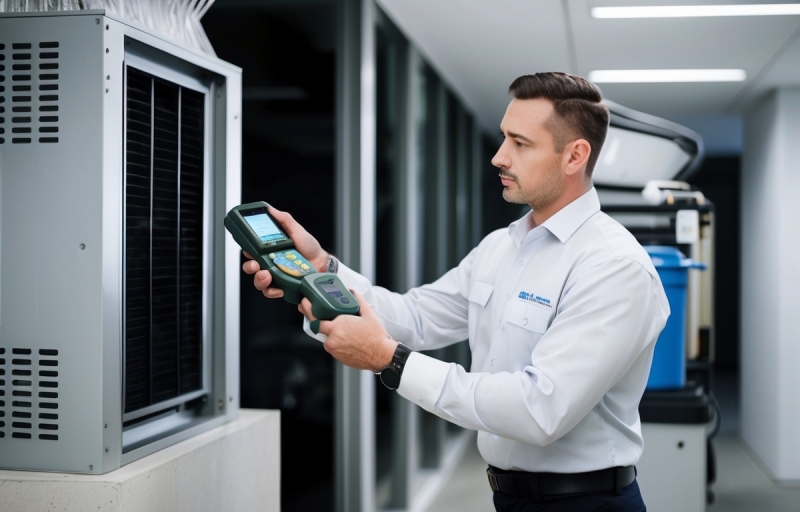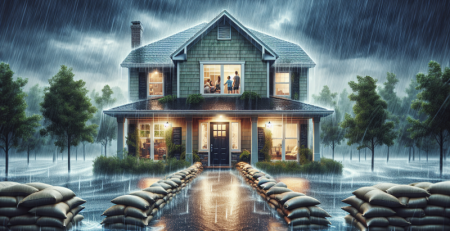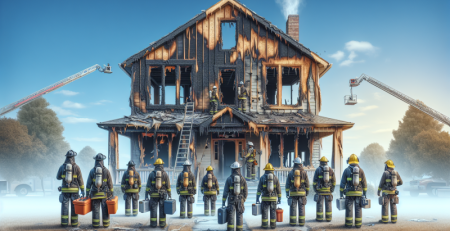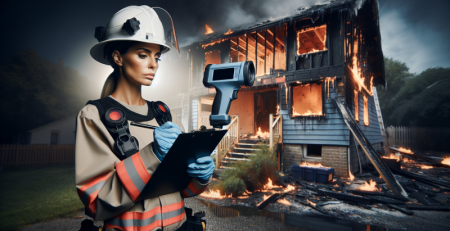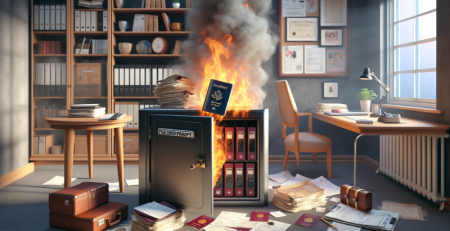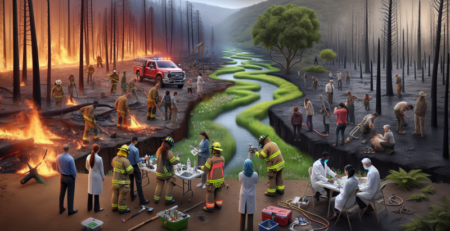The Importance of Air Quality After Fire Damage
After a fire, many homeowners focus on visible damage, but the air quality in your home is equally critical. Did you know that smoke and soot can linger long after the flames are extinguished, posing serious health risks? Ensuring clean air is essential for the safety and well-being of everyone in the space, making air quality a top priority in fire damage restoration.
Air quality can be severely compromised by harmful particles and chemicals released during a fire. These contaminants can lead to respiratory issues, allergies, and other health problems if not properly addressed. At Kraus Restoration, we understand the importance of restoring not just your property but also the air you breathe, ensuring a safe environment for you and your family.
But addressing air quality is just one aspect of the comprehensive fire damage restoration process. Our IICRC certified experts are equipped to tackle all facets of recovery, from smoke and soot cleanup to structural repairs. So, let’s delve deeper into the critical steps you need to take to ensure your home is safe and healthy after fire damage.
Understanding Fire Damage and Its Impact on Air Quality
Fire damage refers to the destruction caused by flames, heat, and smoke. Common causes include wildfires and structural fires. When a fire occurs, it releases a variety of pollutants into the atmosphere. These pollutants include particulate matter and volatile organic compounds (VOCs). Particulate matter consists of tiny particles that can penetrate deep into the lungs, posing serious health risks.
The immediate effects of smoke and soot on air quality are alarming. They can lead to respiratory issues, eye irritation, and reduced visibility. Furthermore, the long-term impact can be equally concerning. Prolonged exposure to these pollutants may contribute to chronic health conditions, including asthma and cardiovascular diseases.
Restoring air quality after fire damage is crucial. Effective cleanup and remediation strategies can significantly improve the environment. For more information on how to address these issues, visit our fire cleanup services. Additionally, understanding the broader implications of air quality can help communities recover. Explore our residential design projects for insights into creating healthier living spaces.
The Composition of Smoke and Its Health Implications
Smoke from fires contains a complex mixture of harmful chemicals. For instance, burning wood releases particulate matter, carbon monoxide, and volatile organic compounds. In contrast, fires involving plastics emit toxic substances like dioxins and furans. Chemical fires can produce even more hazardous materials, including heavy metals and corrosive gases.
Inhaling smoke poses significant health risks. Short-term exposure can lead to respiratory issues, such as coughing and shortness of breath. Long-term exposure increases the risk of chronic diseases, including asthma and lung cancer. According to the World Health Organization, air pollution from smoke contributes to millions of premature deaths annually.
A study published in the journal Environmental Health Perspectives found that individuals exposed to smoke after a fire are at a higher risk of developing respiratory conditions. Furthermore, children and the elderly are particularly vulnerable to these health impacts. Therefore, ensuring proper air quality after fire damage is crucial. For more information on how to address these issues, visit our fire cleanup services or learn about our water cleanup solutions.
Assessing Air Quality After a Fire
Assessing air quality in areas affected by fire requires a systematic approach. First, utilize air quality monitoring stations strategically placed throughout the region. These stations provide real-time data on pollutants. Additionally, portable air quality sensors offer flexibility for localized assessments. They can be deployed in specific areas to gather targeted information.
While DIY methods may seem appealing, professional air quality assessments are crucial. Experts possess the knowledge and tools to accurately evaluate air quality. They can identify hazardous substances that may go unnoticed by untrained individuals. Furthermore, professionals ensure compliance with safety regulations, providing peace of mind.
Interpreting air quality index (AQI) readings is essential for understanding safety levels. The AQI ranges from 0 to 500, with lower values indicating better air quality. Generally, an AQI below 50 is considered good, while values between 51 and 100 are moderate. Levels above 100 signal potential health concerns. For more detailed information on air quality assessments, visit our about page or explore our fire cleanup services. If you have questions, feel free to contact us.
Remediation Strategies for Improving Air Quality
After experiencing fire damage, improving air quality is crucial for health and safety. Start by using air purifiers equipped with HEPA filters. These devices effectively capture smoke particles and harmful pollutants. Additionally, ensure proper ventilation throughout your home. Open windows and doors to allow fresh air to circulate, which helps dilute contaminants.
Cleaning surfaces is another essential step. Use a damp cloth to wipe down walls, ceilings, and furniture. This action removes soot and other residues. For more extensive damage, consider hiring professional remediation services. Experts can assess the situation and provide specialized equipment for thorough cleaning. They are particularly valuable when smoke damage is extensive or when health risks are present.
Homeowners can also implement DIY remediation techniques. Baking soda can absorb odors, while vinegar is effective for neutralizing smoke smells. However, always prioritize safety. If the damage is severe, do not hesitate to contact professionals. Their expertise ensures that your home returns to a safe and healthy environment. For more information on available services, visit our services page.
The Role of Local and Federal Agencies in Air Quality Management
Local and federal agencies play a crucial role in monitoring and managing air quality after fire damage. They are responsible for assessing the impact of smoke and pollutants on public health. These agencies implement regulations that limit harmful emissions and ensure compliance with air quality standards. For instance, the Environmental Protection Agency (EPA) sets guidelines that local authorities must follow to protect communities from hazardous air conditions.
In addition to regulations, various resources are available for communities affected by fire damage. Local health departments often provide information on air quality levels and safety measures. They may also offer support services to help residents recover from the aftermath of a fire. Furthermore, agencies collaborate with organizations to facilitate fire cleanup efforts, ensuring that air quality is restored as quickly as possible.
Residents can access valuable information through community outreach programs. These initiatives educate the public about the importance of air quality and available resources. For more details on recovery services, visit our services page. Additionally, if you have questions, feel free to contact us for assistance.
Long-Term Effects of Fire Damage on Air Quality
Fire damage can create persistent air quality issues that last long after the flames are extinguished. For instance, smoke particles can linger in the air, affecting respiratory health. Additionally, the moisture from firefighting efforts can lead to mold growth, which poses further risks. Mold spores can circulate, causing allergic reactions and other health problems.
Communities that have experienced devastating fires often face long-term air quality challenges. In Paradise, California, for example, residents reported ongoing respiratory issues years after the 2018 Camp Fire. The smoke and ash left behind created a toxic environment, leading to increased hospital visits for respiratory ailments.
Moreover, prolonged exposure to poor air quality can result in serious health complications. Individuals may develop chronic conditions, such as asthma or bronchitis, which can significantly impact their quality of life. Addressing these air quality concerns is crucial for community health. For more information on how to mitigate these risks, visit our mold cleanup and fire cleanup services.
Community Awareness and Education
Community awareness plays a crucial role in addressing air quality issues following fire damage. Residents must understand the potential risks associated with smoke and soot exposure. To effectively educate the public, local organizations can host workshops that provide valuable information on air quality and remediation efforts. Additionally, distributing informational pamphlets can help spread awareness about the importance of monitoring air quality after a fire.
Social media serves as a powerful tool for raising awareness. Local organizations can utilize platforms like Facebook and Twitter to share updates, tips, and resources related to air quality. By engaging the community online, they can foster a sense of urgency and encourage proactive measures. Furthermore, collaboration with environmental experts can enhance the credibility of the information shared.
For those seeking professional assistance, exploring fire cleanup services can provide essential support. Additionally, understanding the broader implications of air quality can lead to better community health outcomes. Ultimately, informed communities can take decisive action to protect themselves and their environment. For more information, visit our about page or contact us directly.
Frequently Asked Questions (FAQs)
After a fire, immediate health risks can arise from inhaling smoke and toxic fumes. Symptoms may include respiratory issues, headaches, and skin irritation. To assess your home’s air quality, consider using an air quality monitor or hiring professionals for testing. If you notice persistent health problems, seek medical advice promptly.
For smoke removal, specific air purifiers equipped with HEPA filters are highly effective. These devices capture fine particles and improve indoor air quality. Typically, it takes several days to weeks for air quality to return to normal, depending on the extent of the damage and cleanup efforts.
Signs of poor air quality include lingering odors, visible soot, and increased allergy symptoms. To prevent future air quality issues, ensure proper ventilation and consider regular inspections. Engaging professionals for fire cleanup can significantly mitigate risks. Additionally, maintaining your home’s water cleanup systems can help prevent mold growth, which often follows fire damage. For more information, feel free to contact us.
Conclusion: The Ongoing Importance of Air Quality Monitoring
Ensuring air quality after fire damage is crucial for health and safety. Continuous monitoring plays a vital role in identifying potential hazards. Proactive measures, such as regular assessments and remediation, help maintain a safe environment. Furthermore, understanding the long-term effects of smoke and soot exposure is essential. These pollutants can linger, affecting indoor air quality significantly.
Engaging with local air quality initiatives empowers communities. By staying informed, residents can take action to protect themselves and their families. Additionally, collaborating with professionals ensures effective solutions are implemented. For instance, fire cleanup services can help restore safety in affected areas.
Moreover, awareness of available resources fosters a proactive approach. Regular updates on air quality can guide individuals in making informed decisions. Therefore, it is imperative to prioritize air quality monitoring. Ultimately, a commitment to ongoing vigilance will lead to healthier living spaces for everyone. For more information on how to safeguard your environment, visit our about page or explore our services.
